|
|
|
Sort Order |
|
|
|
Items / Page
|
|
|
|
|
|
|
| Srl | Item |
| 1 |
ID:
149479
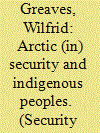

|
|
|
|
|
| Summary/Abstract |
While international relations has increasingly begun to recognize the political salience of Indigenous peoples, the related field of security studies has not significantly incorporated Indigenous peoples either theoretically or empirically. This article helps to address this gap by comparing two Arctic Indigenous peoples – Inuit in Canada and Sámi in Norway – as ‘securitizing actors’ within their respective states. It examines how organizations representing Inuit and Sámi each articulate the meaning of security in the circumpolar Arctic region. It finds that Inuit representatives have framed environmental and social challenges as security issues, identifying a conception of Arctic security that emphasizes environmental protection, preservation of cultural identity, and maintenance of Indigenous political autonomy. While there are some similarities between the two, Sámi generally do not employ securitizing language to discuss environmental and social issues, rarely characterizing them as existential issues threatening their survival or wellbeing.
|
|
|
|
|
|
|
|
|
|
|
|
|
|
|
|
| 2 |
ID:
159347
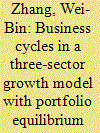

|
|
|
|
|
| Summary/Abstract |
This study generalises a growth model proposed by Zhang (2016) through allowing all the time-dependent variables to be time-dependent. Zhang’s model deals with dynamic interdependence between capital accumulation and environmental change, with portfolio equilibrium among land, gold and physical wealth in a multi-sector general equilibrium framework. The model explains the dynamics of prices, rents and distribution of land, gold, physical wealth and environmental change on the basis of micro-economic foundation. This article generalises the model to explain business cycles due to different exogenous shocks. We simulate the motion of the economy and conduct comparative dynamic analysis to demonstrate business cycles due to periodic oscillations in the propensity to use gold, the propensity to consume housing, the propensity to consume industrial goods, the propensity to consume agricultural goods, the propensity to save, and the tax rate on the consumption of industrial goods.
|
|
|
|
|
|
|
|
|
|
|
|
|
|
|
|
| 3 |
ID:
139406
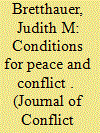

|
|
|
|
|
| Summary/Abstract |
This study applies fuzzy-set Qualitative Comparative Analysis (fsQCA) to the debate on links between resource scarcity and armed conflict. Previous studies on this relationship have reached contradictory results. This study aims to solve this contradiction by arguing that social, economic, and political conditions play an important role in determining whether armed conflict erupts over resource scarcity. I test three theoretic hypotheses, focusing on weak states, economic situations of households, and human ingenuity. I compare fifteen resource scarce cases with conflict to sixteen cases without armed conflict. My analysis supports the hypothesis that the economic situation of households and the levels of human ingenuity matter. In particular, the impact of high dependence on agriculture and low levels of tertiary education on the link between resource scarcity and conflict is discussed. While employing an fsQCA proves a valuable step in accounting for contradictory results, limits of the methods are apparent as well.
|
|
|
|
|
|
|
|
|
|
|
|
|
|
|
|
| 4 |
ID:
116163
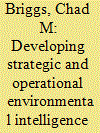

|
|
|
|
|
| Publication |
2012.
|
| Summary/Abstract |
This article examines the role of environmental change in conducting intelligence assessments, and the important role in integrating scientific data with background assumptions behind military and security planning. Tracing the development of environmental security concepts, recent military and intelligence interest in climate and environmental changes are based on practical concerns over critical vulnerabilities of infrastructure, energy supplies, and system stability. Examples from Central Asia illustrate the cascading nature of environmental security risks, particularly with water and energy systems. The discussion follows with how scenarios and risk assessments can be integrated with concepts from environmental net assessments, and why traditional assumptions of probabilities, uncertainties and secrecy may be misleading. It is essential to understand not only how extreme future changes might be, but what capabilities we and allies posses to adapt to environmental-related hazards.
|
|
|
|
|
|
|
|
|
|
|
|
|
|
|
|
| 5 |
ID:
090058
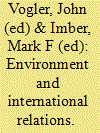

|
|
|
|
|
| Publication |
London, Routledge, 1996.
|
| Description |
236p.
|
| Series |
Global environmental change series
|
| Standard Number |
9780415122153
|
|
|
|
|
|
|
|
|
|
|
|
Copies: C:1/I:0,R:0,Q:0
Circulation
| Accession# | Call# | Current Location | Status | Policy | Location |
| 054366 | 363.7/VOG 054366 | Main | On Shelf | General | |
|
|
|
|
| 6 |
ID:
104267
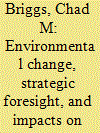

|
|
|
| 7 |
ID:
144585


|
|
|
|
|
| Summary/Abstract |
Global environmental history is currently being enriched by troves of new data, and new models of environmental variability and human impact. Earth scientists are rapidly expanding historians’ knowledge of the paleoclimate through the recovery and analysis of climate proxies such as ice cores, tree rings, stalagmites, and marine and lake sediments. Further, archaeologists and anthropologists are using novel techniques and methods to study the history of health and disease, as revealed through examination of bones and paleomolecular evidence. These possibilities open the way for historians to participate in a conversation about the long history of environmental change and human response. This essay considers how one of the most classic of all historical questions–the fall of the Roman Empire–can receive an answer enriched by new knowledge about the role of environmental change.
|
|
|
|
|
|
|
|
|
|
|
|
|
|
|
|
| 8 |
ID:
123818
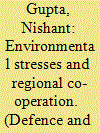

|
|
|
| 9 |
ID:
131365


|
|
|
|
|
| Publication |
2014.
|
| Summary/Abstract |
Despite criticism, global biofuel production continues to rise, using primarily food crops. Between 2001 and 2012 it increased nearly six-fold, driven primarily by domestic policies, yet raising strong international concerns, eg over impacts on global food prices. Nevertheless, little international biofuel governance has emerged. This article examines the various extraterritorial dimensions of domestic biofuel policies and investigates why international biofuel governance has remained vague, despite its controversial nature. It uses the politics of scale to analyse why countries may wish to frame it as a global or domestic issue. Three extraterritorial dimensions are identified: global environmental impacts, global socioeconomic impacts, and attempts at extraterritorial control over biofuel production abroad. While major producers have successfully avoided liability for impacts by preventing the scaling up of much biofuel governance to the international level, major importers have tried to fill perceived governance gaps using policies aimed at extraterritorial control. We show that both the rise of nationally oriented development policies with extraterritorial impacts and of unilateral sustainability rule making primarily affect weaker countries, making global inequalities more pronounced. It is essential that adaptation governance take into account both environmental and global socioeconomic changes, such as higher agricultural commodity prices.
|
|
|
|
|
|
|
|
|
|
|
|
|
|
|
|
| 10 |
ID:
094374
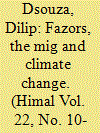

|
|
|
| 11 |
ID:
119128
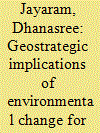

|
|
|
| 12 |
ID:
125306
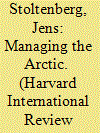

|
|
|
|
|
| Publication |
2013.
|
| Summary/Abstract |
To most people the Arctic is a distant realm, almost another world, inhabited by polar bears. They may even think the frigid landmasses and icy seas of the Arctic are irrelevant to daily life further south. However, the Arctic is changing rapidly. The melting of the sea ice has thrust the region into the global spotlight as world leaders seek to assess both the environmental threats and economic opportunities of a smaller northern ice cap. Norwegians have long balanced a fierce commitment to environmental protection with our substantial Arctic economic interests, and we are eager to help devise responses to the worrying changes we have all observed. The Arctic encompasses more than 15 million square miles or about 8 percent of the surface of the Earth, equivalent to four times the extent of U.S. territory. But the human residents of this vast area number only about 4 million, and are spread across eight countries - Norway, Russia, the United States, Canada, Finland, Sweden, Iceland and Denmark.
|
|
|
|
|
|
|
|
|
|
|
|
|
|
|
|
| 13 |
ID:
139949
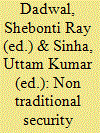

|
|
|
|
|
| Publication |
New Delhi, Routledge, 2015.
|
| Description |
xxxiv, 393p.Hbk
|
| Standard Number |
9781138892538
|
|
|
|
|
|
|
|
|
|
|
|
Copies: C:1/I:0,R:0,Q:0
Circulation
| Accession# | Call# | Current Location | Status | Policy | Location |
| 058272 | 355.03305/DAD 058272 | Main | On Shelf | General | |
|
|
|
|
| 14 |
ID:
114620
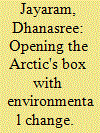

|
|
|
|
|
| Publication |
2012.
|
| Summary/Abstract |
This is posturing. This is the true north - strong and free, and they're
fooling themselves if they think dropping a flag on the ocean floor is going
to change anything. There is no question over Canadian sovereignty in
the Arctic. We've made that very clear. We've established - a long time
ago - that these are Canadian waters and this is Canadian property. You
can't go around the world these days dropping a flag somewhere. This
isn't the 14th or 15th century.
|
|
|
|
|
|
|
|
|
|
|
|
|
|
|
|
| 15 |
ID:
123246
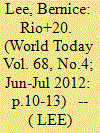

|
|
|
| 16 |
ID:
092076
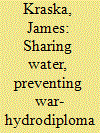

|
|
|
|
|
| Publication |
2009.
|
| Summary/Abstract |
Over the past decade, scholars have closely examined the linkage between environmental change, security, and conflict. Severe deforestation, soil erosion, soil salinisation and water-logging, toxic contamination, drought and flooding, and air and water pollution are some of the environmental calamities that can increase international tension and even lead to conflict. What is perhaps more interesting, however, is that reversing the equation is also true. Environmental conservation and cooperative governance between neighbouring states can contribute to regional stability and conflict avoidance. This article suggests the international trans-boundary river agreement between India and Pakistan to manage the Indus River reduces tension and prevents war between the nuclear-armed rivals. During the Kargil crisis in 2001, for example, the trans-boundary river management regime was the most functional bilateral relationship between the two South Asian powers.
|
|
|
|
|
|
|
|
|
|
|
|
|
|
|
|
| 17 |
ID:
152297


|
|
|
|
|
| Summary/Abstract |
How will local violent conflict patterns in sub-Saharan Africa evolve until the middle of the 21st century? Africa is recognized as a particularly vulnerable continent to environmental and climate change since a large portion of its population is poor and reliant on rain-fed agriculture. We use a climate-sensitive approach to model sub-Saharan African violence in the past (geolocated to the nearest settlements) and then forecast future violence using sociopolitical factors such as population size and political rights (governance), coupled with temperature anomalies. Our baseline model is calibrated using 1° gridded monthly data from 1980 to 2012 at a finer spatio-temporal resolution than existing conflict forecasts. We present multiple forecasts of violence under alternative climate change scenarios (optimistic and current global trajectories), of political rights scenarios (improvement and decline), and population projections (low and high fertility). We evaluate alternate shared socio-economic pathways (SSPs) by plotting violence forecasts over time and by detailed mapping of recent and future levels of violence by decade. The forecasts indicate that a growing population and rising temperatures will lead to higher levels of violence in sub-Saharan Africa if political rights do not improve. If political rights continue to improve at the same rate as observed over the last three decades, there is reason for optimism that overall levels of violence will hold steady or even decline in Africa, in spite of projected population increases and rising temperatures.
|
|
|
|
|
|
|
|
|
|
|
|
|
|
|
|
|
|
|
|
|